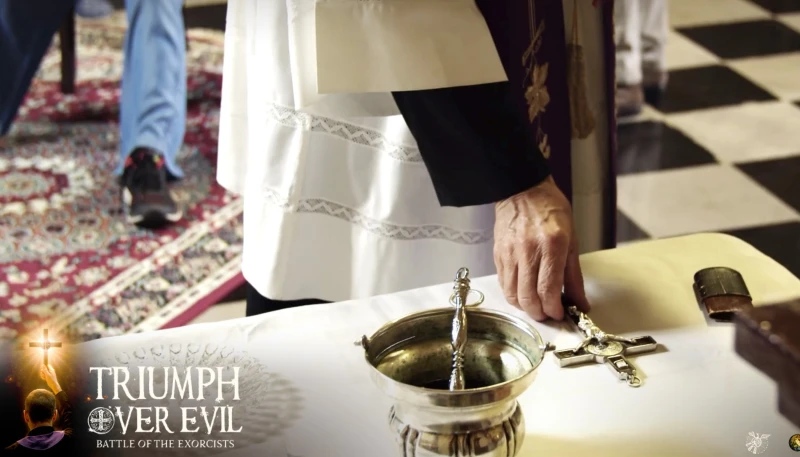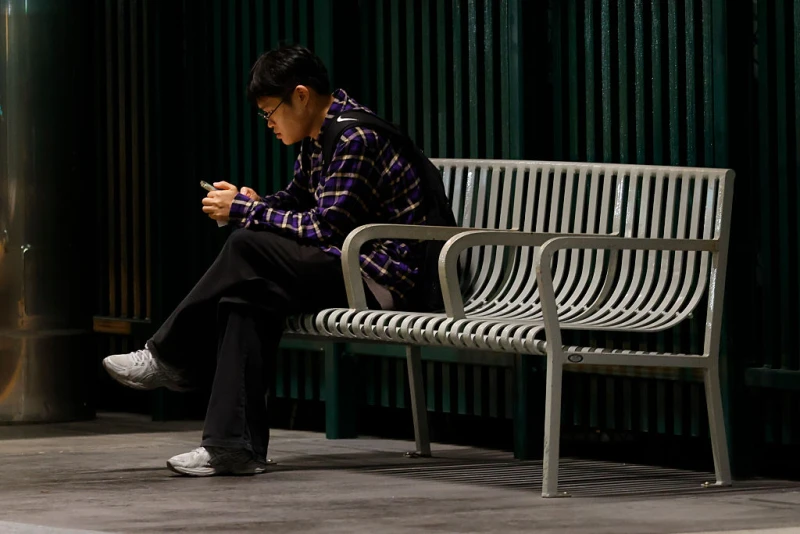
| Picture of the day |
|---|

|
|
American actress Margaret Qualley at 70th Berlin International Film Festival. Today is her birthday.
|

| Picture of the day |
|---|

|
|
American actress Margaret Qualley at 70th Berlin International Film Festival. Today is her birthday.
|


CNA Staff, Oct 28, 2025 / 07:00 am (CNA).
Who is the devil? What is an exorcism? How do you protect yourself from demonic attacks? These are some of the questions a new film titled “Triumph Over Evil: Battle of the Exorcists” aims to answer.
Approved by the International Association of Exorcists, a prominent pontifical association, “Triumph Over Evil” is the first authoritative documentary to delve into the various aspects of demonic possession and exorcism as well as the how the Catholic priesthood and the Blessed Virgin Mary take part in the battle against evil.
The film, which includes never-before-seen commentary from Vatican exorcist Father Gabriele Amorth and others, will be in theaters for one day only on Oct. 30.
Giovanni Ziberna, a former atheist who converted to Catholicism, directs the film.
Despite growing up in an atheist household, Ziberna told CNA in an interview that he always felt like God existed.
“The beauty of creation always made me feel that there had to be something more,” he said.
The Italian film director shared that it was not until he and his wife were asked to work on a project on the life of St. Veronica Giuliani — an Italian nun and mystic who belonged to the Capuchin Poor Clares — that he first encountered God. He explained that after receiving a blessing for protection from the priests involved in the project, he began to feel a “fire starting from my feet and rising up all over my body.”
“This fire burned away all my preconceived ideas, my pride, my ego, what I thought about God,” he said. “In that moment, I realized that it was God who humbled himself to embrace us in our smallness and misery and also that fire lit in me the desire to conversion, to be baptized; and the desire to know the faith and the Scriptures.”
From that point on, he and his wife started their faith journey. They began receiving the sacraments, getting baptized as well as baptizing their children, and having their civil marriage recognized by the Catholic Church.
After becoming Catholic, Ziberna had the opportunity to assist in the ministry of exorcism, where he served as a firsthand witness. This experience inspired him to create the film as a way to show the truth about exorcisms, in contrast to what Hollywood depicts.
He explained that there is a lot of “misinformation” surrounding this topic, as well as a lack of “theological background,” making it “easy to fall in the devil’s trap.”
Through the film, Ziberna said he wants to “show what a real exorcism is” and how it serves as a “spiritual moment full of light where God’s power wins over darkness.”
Ziberna said he hopes viewers will come away with more knowledge, a desire to “stay closer to God,” and a reminder that the “only real winner over evil is God.”
Read More

Washington, D.C. Newsroom, Oct 21, 2025 / 07:00 am (CNA).
A controversial ad campaign posted in the New York City subway system has sparked criticism and vandalism over the past few weeks. The print ads are selling an AI companion necklace called “Friend” that promises to be “someone who listens, responds, and supports.”
The device first launched in 2024, retailing at $129. It is designed to listen to conversations, process the information, and send responses to the user’s phone via a connected app. While users can tap the disc’s button to prompt an immediate response, the product will also send unprompted texts. The device’s microphones don’t offer an off switch, so it is constantly listening and sending messages based on conversations it picks up.
CNA did not receive a response to a question from Friend.com about the success of its subway ad campaign and how many people are currently using the devices, but Sister Nancy Usselmann, FSP, director of the Daughters of St. Paul’s Pauline Media Studies who also studies AI, told CNA that “people are turning to AI for companionship because they find human relationships too complicated.”
But “without that complicatedness, we cannot grow to become the best that we can be. We remain stagnant or selfish, which is a miserable existence,” she said.
Avi Schiffmann, the 22-year-old who started Friend.com, was a Harvard student before leaving school to focus on a number of projects. At 18, he created a website that tracked early COVID-19 data from Chinese health department sources. In 2022, he built another website that matched Ukrainian refugees with hosts around the world to help them find places to stay. He then founded Friend and now serves as the company’s CEO.
Schiffmann and his company first turned heads when an eerie video announcing the new gadget was released in July 2024. The advertisement featured four different individuals interacting with their “friends.” One woman takes a hike with her pendant, while another watches a movie with hers. A man gets a text from his “friend” while playing video games with his human friends. He first appears to be sad and lonely around his friends, until his AI “friend” texts him, which appears to put him at ease.
The marketing video ends with a young man and woman spending time together as the woman discusses how she has only ever brought “her” to where they are hanging out, referencing her AI gadget.
“It’s so strange because it’s awkward to have an AI in between a human friendship,” Usselmann said about the video ad.
Hundreds took to the comments section of the YouTube video to respond — mostly negatively — to both the Friend.com ads and the technology. Commentators called out the company for capitalizing on loneliness and depression. One user even called the video “the most dystopian advertisement” he had ever seen, and others wrote the video felt like a “horror film.”
“While its creators might have good intentions to bring more people the joys of companionship, they are misguided in trying to achieve this through a digital simulacrum,” Father Michael Baggot, LC, professor of bioethics at the Pontifical Athenaeum Regina Apostolorum in Rome, told CNA.
The device “suffers from a misnomer, since authentic friendship involves an interpersonal relationship of mutual support,” said Baggot, who studies AI chatbots and works on the development of the Catholic AI platform Magisterium AI.
“The product risks both worsening the loneliness epidemic by isolating users from others and undermining genuine solitude by intruding on quiet moments with constant notifications and surveillance. Friend commodities connection and may exploit human emotional vulnerabilities for profit,” he said, adding: “It might encourage users to avoid the challenging task of building real relationships with people and encourage them to settle for the easily controllable substitute.”
Usselmann agreed. “Only by reaching out in genuine compassion and care can another person who feels lonely realize that they matter to someone else,” she said. “We need to get to know our neighbors and not remain so self-centered in our apartments, neighborhoods, communities, or places of work.”
In a post to social media platform X on Sept. 25, Schiffmann announced the launch of the subway ad campaign. The post has more than 25 million views and nearly 1,000 comments criticizing the pendant and campaign — and some commending them.
Dozens of the ads have since been torn up and written on. People have posted images to social media of the vandalized ads with messages about the surveillance dangers and the general threats of chatbots. One urged the company to “stop profiting off of loneliness,” while another had “AI is not your friend” written on it.
One person added to the definition of “friend,” writing it is also a “living being.” It also had the message: “Don’t use AI to cure your loneliness. Reach out into the world!”
Usselmann said the particular issue with the campaign and device is “the tech world assuming certain words and giving them different connotations.”
“A ‘friend’ is someone with whom you have a bond based on mutual affection,” she said. “A machine does not have real affection because it cannot love. It does not have a spiritual soul from which intellect, moral agency, and love stem.”
She continued: “And from a Christian understanding, a friend is someone who exhibits sacrificial love, who supports through the ups and downs of life, and who offers spiritual encouragement and forgiveness. An AI ‘friend’ can do none of those things.”
Read More

CNA Staff, Oct 4, 2025 / 08:00 am (CNA).
Kevin Matthews was at the top of his game as one of the most famous on-air radio personalities in Chicago in the 1980s and ’90s. He was partying with professional athletes and celebrities and posting 10 million listeners a week at the peak of his popularity.
All of that changed when he received a life-altering medical diagnosis. Yet the biggest change in his life happened when he found a broken Virgin Mary statue in the trash.

“Broken Mary: The Kevin Matthews Story” is a new documentary recounting Matthews’ true story of fame, brokenness, and finding redemption in Jesus Christ thanks to his devotion to the Blessed Mother. The documentary will be in theaters for one night only on Oct. 7, the feast of Our Lady of the Rosary.
Matthews was born and raised in Pontiac, Michigan, in a Catholic household. As a child he struggled to read and write, though it wasn’t until he was an adult that he discovered he was dyslexic.
In order to prevent himself from getting beaten up by both kids in his neighborhood and his physically abusive father, he used comedy and making others laugh as a shield he could hide behind.

In college Matthews was first introduced to radio through his roommate’s hosting of a show at the student station. In 1987, he began his career with “The Loop” AM 1000 in Chicago. It was here that he rose to fame and became known for his edgy humor, sharp wit, and comedic characters — the most popular being “Jim Shorts.”
Yet after years of mega-success, his life began to unravel when he was diagnosed with multiple sclerosis (MS) in 2008. It became more difficult to be on-air and new radio personalities were on the rise. But it wasn’t until 2011 that he had a life-changing experience.
Matthews told CNA in an interview that while driving on his way home from just having been fired from his job, he “heard the Holy Spirit say, ‘Go and get your wife some flowers.’” He pulled into a flower shop he happened to be passing at the time.
“I got out of my car and I’m starting to walk towards the door and over by the dumpster, I see a statue of the Virgin Mary,” he recalled. “I walked over to it and there she is on the ground broken in half. She’s looking up at me. Her hands are broken. She’s sunk in the mud, so she’s been there for a while, she’s got garbage on her.”
“And I’m a zombie Catholic at that point, I’m not religious,” he said, “but I knew at that moment, no one treats our Blessed Mother like that.”
“I just was appalled, but then I heard the voice of Christ say to me, ‘Will you deny me? Will you deny my mother?’ And I was like, ‘What do I do?’”
Matthews entered the store and told the store clerk that he wanted to buy the broken Mary statue out by the dumpster. Though the store clerk said it was not for sale, he recognized Matthews’ voice from the radio and allowed him to take the statue.
The statue weighed 73 pounds and due to his MS and a recent snowstorm, it took Matthews nearly an hour to get the broken Mary statue from out of the ground and into the back of his car.
“I remember I turned the heat up and I said, ‘Mary, I will take care of you for the rest of my life,’” Matthews shared.
He called a priest friend and told him about the broken statue. The priest told him about a sculptor who could fix her. Matthews took the broken Mary and was told that she could be completely restored.
“That was the first time I really cried in front of a total stranger and said, ‘Don’t you dare touch her.’ I said, ‘That is me.’ And I said, ‘She’s broken like me. Just keep her broken. Just put her together, keep her hands broken, don’t paint her — she’s broken Mary,” he said.
From then on, Matthews began to go back to Mass, he learned how to pray the rosary, and he completely left his life of luxury to instead take his broken statue of Mary to parishes across the country to share how his life was radically changed by the Blessed Mother.
Matthews said he hopes the film will show “that we’re all broken, but we’re loved by God and just go to him … I’ve never been happier in my life.”
Read More
| Picture of the day |
|---|

|
|
Actress Mitzi Akaha 2024 at the Sundance Film Festival in Park City, Utah. Today kicks off the 41st edition of the famous festival.
|


A color enhancement of a far-ultraviolet photo of Earth taken by astronaut John W. Young, commander, with the ultraviolet camera on April 21, 1972. The original black-and-white photo was printed on Agfacontour film three times, each exposure recording only one light level. The three light levels were then colored blue (dimmest), green (next brightest), and red (brightest).
Read More